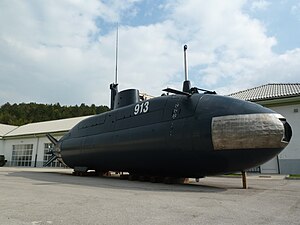Una-class submarine

Restored Zeta (P-913) exhibited at the Pivka Military History Park in Slovenia.
|
|
| Class overview | |
|---|---|
| Builders: | Brodogradilište specijalnih objekata (BSO), Split, SR Croatia, SFR Yugoslavia |
| Built: | 1985–1989 |
| Completed: | 6 |
| General characteristics | |
| Displacement: |
|
| Length: | 18.82 m (61 ft 9 in) |
| Draught: | 2.4 m (7 ft 10 in) |
| Depth: | 120 m (390 ft) |
| Propulsion: | 2 × 18 kW (24 hp) electric motor |
| Speed: |
|
| Range: | 250–270 nmi (463–500 km; 288–311 mi) at 3 knots (6 km/h; 3 mph) |
| Endurance: | 96–160 hours (depending on number of personnel onboard) |
| Complement: | 4 + 6 naval commandos |
| Armament: |
|
The Una-class submarine (also known as Type 911) was a class of six midget submarines built for the Yugoslav Navy at the Brodogradilište specijalnih objekata (English: Special objects shipyard) during the 1980s. They were designed with the purpose of laying small minefields and transporting naval special forces, with or without their submersibles, in shallow waters that were inaccessible for larger submarines. Due to their mission profile that called for a small design as well as the need to stay undetected, they lacked torpedo armament and a generator for battery recharging.
During the Croatian War of Independence and the dissolution of SFR Yugoslavia, five of the six boats were relocated to Boka Kotorska where they served with the SR Yugoslav Navy. One, Soča (P-914), was captured in drydock by Croatian forces. It was later modified and entered service with the Croatian Navy as Velebit (P-01). All of the boats have since been decommissioned.
During the 1970s the Brodarski Institute (BI) from Zagreb started working on a new class of submarines for the Yugoslav Navy (JRM). The project, designated B-91 and led by Lieutenant Colonel Davorin Kajić, was tasked with developing a class of midget submarines capable of operating in the shallow waters of the northern Adriatic. Using their small dimensions, the submarines were to be able to maneuver in depths as shallow as 10 metres (33 ft); such abilities were needed to conduct offensive minelaying near the enemy coastline, reconnaissance, and transporting naval special forces in hostile waters.
...
Wikipedia
